-
Out of stock
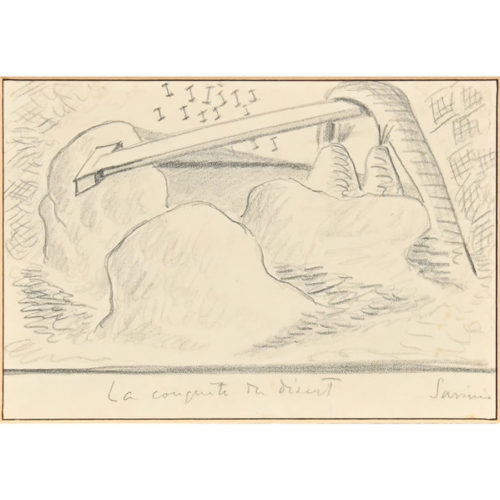 "La coquete du desert" pencil on paper by Alberto Savinio, circa 1929, signed on the lower right. "La conquete du désert" was published under this title in C.g. on p. 247, as of 1929, n.d. 9. Period: circa 1929 Measurements: H 12 x W 17.3 cm
"La coquete du desert" pencil on paper by Alberto Savinio, circa 1929, signed on the lower right. "La conquete du désert" was published under this title in C.g. on p. 247, as of 1929, n.d. 9. Period: circa 1929 Measurements: H 12 x W 17.3 cm -
Out of stock
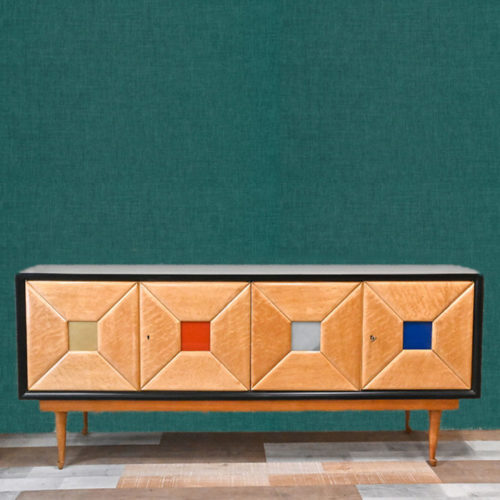 Sideboard, 1950s ash-root with coloured panels and ebonised wooden internal structure. Period: 1950s Measurements: H 89 x W 201 x D 45 cm
Sideboard, 1950s ash-root with coloured panels and ebonised wooden internal structure. Period: 1950s Measurements: H 89 x W 201 x D 45 cm -
Out of stock
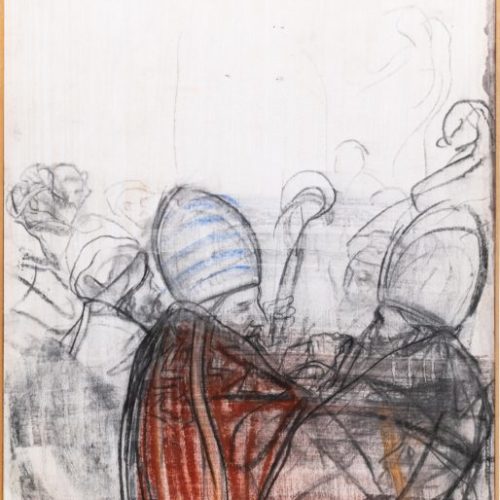 "Glory of St. Benedict" mixed media on paper by Pietro Annigoni (1910-1988), on the reverse side cartouche of the IInd Biennale of Sacred Art of Pescara. Measurements: In frame H 99.5 x W 78.5 x D 10 / Paper H 80 x W 60 cm
"Glory of St. Benedict" mixed media on paper by Pietro Annigoni (1910-1988), on the reverse side cartouche of the IInd Biennale of Sacred Art of Pescara. Measurements: In frame H 99.5 x W 78.5 x D 10 / Paper H 80 x W 60 cm -
Out of stock
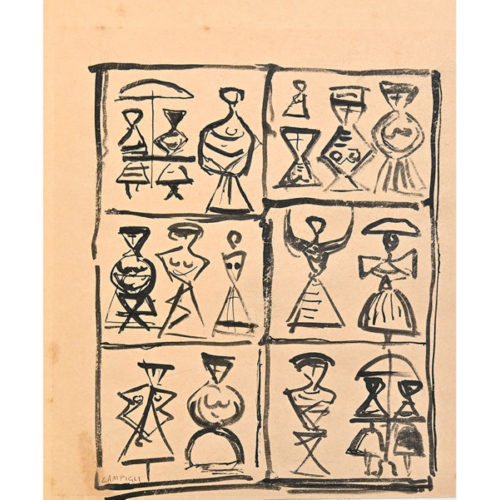 Composition, ink on paper, Massimo Campigli (1895-1971), pencil signature on the lower left. Archive number 4390564, by Nicola Campigli, in Saint Tropez 20 /10 /1991. Measurements: Framed H 51.5 x W 45 x D 2.5 / Drawing H 29.5 x W 26.5 cm
Composition, ink on paper, Massimo Campigli (1895-1971), pencil signature on the lower left. Archive number 4390564, by Nicola Campigli, in Saint Tropez 20 /10 /1991. Measurements: Framed H 51.5 x W 45 x D 2.5 / Drawing H 29.5 x W 26.5 cm -
Out of stock
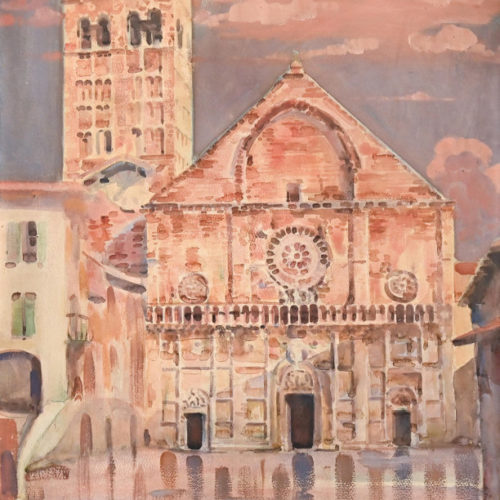 "Cathedral of San Rufino in Assisi", mixed media on cardboard by Luigi Zago (Villafranca di Verona 1894 - Buenos Aires 1952), 1930s. Period: 1930s Measurements: Framed H 95 x W 96,5 x D 7 cm / Cardboard H 78 x W 68 cm
"Cathedral of San Rufino in Assisi", mixed media on cardboard by Luigi Zago (Villafranca di Verona 1894 - Buenos Aires 1952), 1930s. Period: 1930s Measurements: Framed H 95 x W 96,5 x D 7 cm / Cardboard H 78 x W 68 cm -
Out of stock
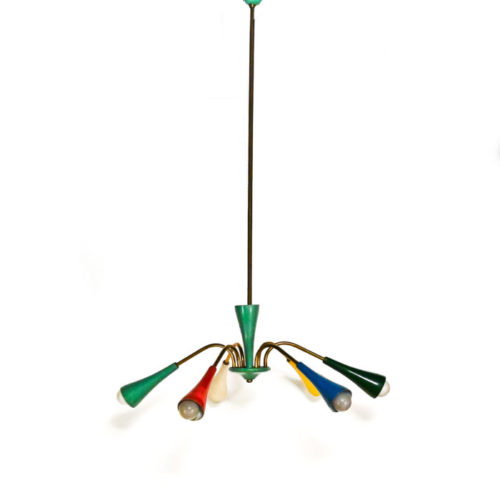
Sputnik chandelier dating back to 1950s, in Stilnovo style.
The chandelier is composed by six light points with brass structure and lampshades, each of which is coloured in a different shade.Period: 1950s
Measurements: H78 x L60 cm. -
Out of stock
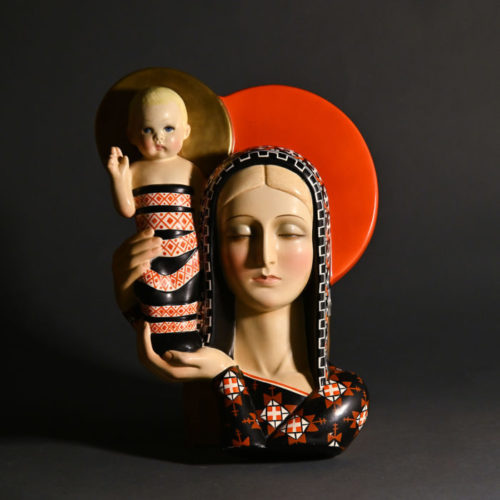 "Pompeian Madonna', Andrea Bologna. Matt polychrome glazed ceramic with gilding. Lenci Factory, Turin, 1936. Signature on the reverse "Lenci Made in Italy Torino". In excellent condition, only a defect on the back. Period: 1936 Measurements: H 28,5 x W 21 x D 7,5 cm
"Pompeian Madonna', Andrea Bologna. Matt polychrome glazed ceramic with gilding. Lenci Factory, Turin, 1936. Signature on the reverse "Lenci Made in Italy Torino". In excellent condition, only a defect on the back. Period: 1936 Measurements: H 28,5 x W 21 x D 7,5 cm -
Out of stock
 Pair of 1950s armchairs of Italian manufacture. The armchairs are in excellent condition, and have their original fabric. Period: 1950s Measurements: H 85 x W 65 x D 76 / Seat height 39 cm
Pair of 1950s armchairs of Italian manufacture. The armchairs are in excellent condition, and have their original fabric. Period: 1950s Measurements: H 85 x W 65 x D 76 / Seat height 39 cm -
Out of stock
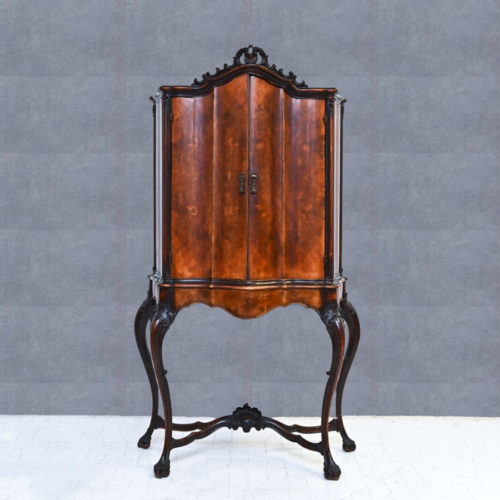 Bar cabinet, from the 1940s, Italian production. The cabinet is made of walnut and walnut briar, it has an internal light. Period: 1940s Measurements: H 170 x W 97 x D 40 cm
Bar cabinet, from the 1940s, Italian production. The cabinet is made of walnut and walnut briar, it has an internal light. Period: 1940s Measurements: H 170 x W 97 x D 40 cm -
Out of stock
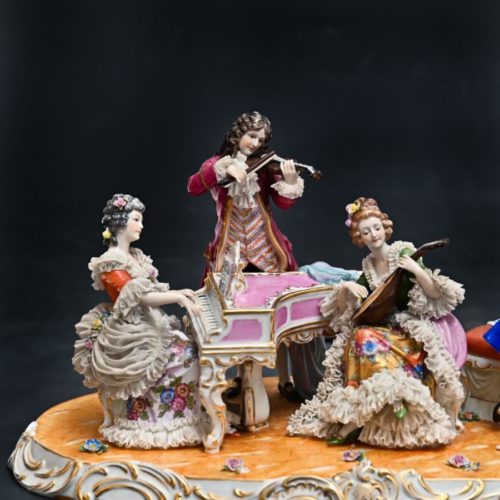 Large porcelain group from Capodimonte, early 20th century, depicting a scene in 18th century dress. Period: Early 20th Century Measurements: H 23,5 x W 48 x D 28 cm
Large porcelain group from Capodimonte, early 20th century, depicting a scene in 18th century dress. Period: Early 20th Century Measurements: H 23,5 x W 48 x D 28 cm -
Out of stock
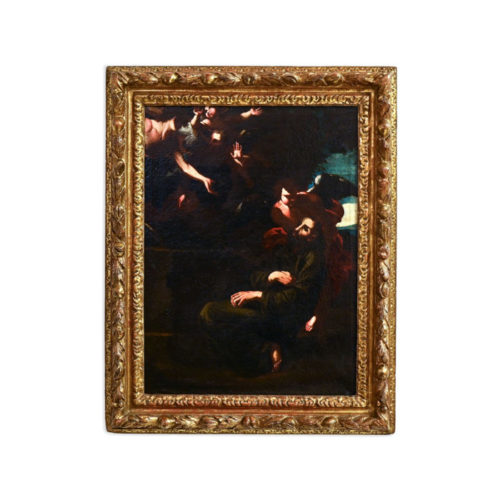 "Ecstasy of St. Francis" oil on canvas from the 17th century, in a coeval frame. Work in excellent condition. The scene of the painting refers to the famous episode in the life of Saint Francis that took place on the Verna mountain in the summer of 1224, when the Saint received the stigmata. Period: 17th century Measurements: Framed H 84.5 x W 66.5 x D 4.5 cm / Canvas H 68 x W 51 cm
"Ecstasy of St. Francis" oil on canvas from the 17th century, in a coeval frame. Work in excellent condition. The scene of the painting refers to the famous episode in the life of Saint Francis that took place on the Verna mountain in the summer of 1224, when the Saint received the stigmata. Period: 17th century Measurements: Framed H 84.5 x W 66.5 x D 4.5 cm / Canvas H 68 x W 51 cm -
Out of stock
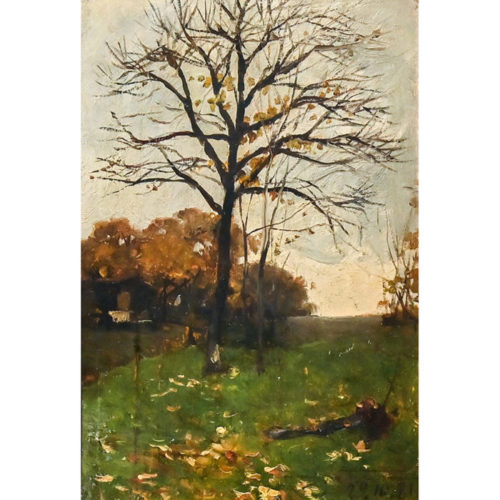 "Last Leaves" oil on panel by Lorenzo Delleani, 25 x 37.3 cm; signed and dedicated: Delleani - to dear brother-in-law Baglioni Giuseppe. Dated 29/10/81. Signed and dated lower right. Private property Biella. Formerly S. Colongo, Biella. Described on page 128 of "Delleani, La vita, l'opera e il suo tempo" by Angelo Dragone. Period: 29/10/81 Measurements: Framed H 57 x W 45 x D 4,5 / Tablet H 37,3 x W 25 cm
"Last Leaves" oil on panel by Lorenzo Delleani, 25 x 37.3 cm; signed and dedicated: Delleani - to dear brother-in-law Baglioni Giuseppe. Dated 29/10/81. Signed and dated lower right. Private property Biella. Formerly S. Colongo, Biella. Described on page 128 of "Delleani, La vita, l'opera e il suo tempo" by Angelo Dragone. Period: 29/10/81 Measurements: Framed H 57 x W 45 x D 4,5 / Tablet H 37,3 x W 25 cm -
Out of stock
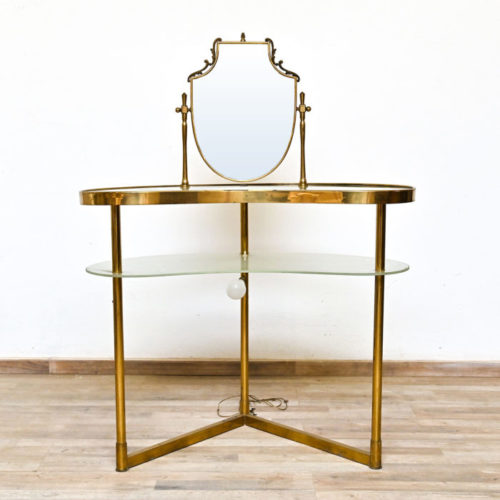 Brass-plated iron bedroom toilet from the 1950s, with lighting on the lower level. The two floors are bean-shaped. Period: 1950s Measurements: H 120 x W 91 x D 49 cm
Brass-plated iron bedroom toilet from the 1950s, with lighting on the lower level. The two floors are bean-shaped. Period: 1950s Measurements: H 120 x W 91 x D 49 cm -
Out of stock
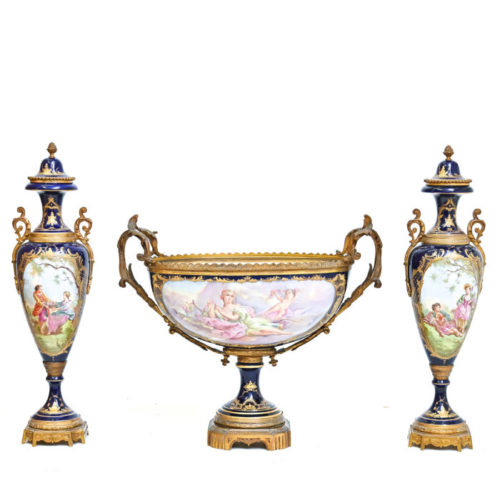 Triptych, bowl and vases Sevres, second half of the 19th century. The triptych is made of painted and gilded cobalt blue ceramic, with gilded bronze applications, in patina. It can be revived and given its original shine. Period: Second half of the 19th century Measurements: Vases H 54,5 x W 14,5 x D 13,5 cm / Cup H 41,5 x W 47,5 x D 25 cm
Triptych, bowl and vases Sevres, second half of the 19th century. The triptych is made of painted and gilded cobalt blue ceramic, with gilded bronze applications, in patina. It can be revived and given its original shine. Period: Second half of the 19th century Measurements: Vases H 54,5 x W 14,5 x D 13,5 cm / Cup H 41,5 x W 47,5 x D 25 cm -
Out of stock
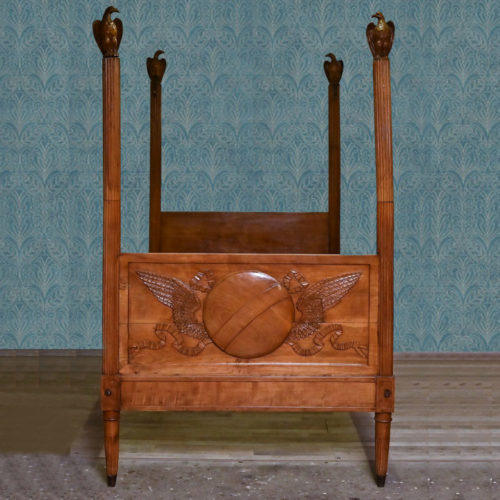 Empire canopy bed in walnut, of French origin. The bed dates from the early 19th century and has columnar uprights and carved eagles. In excellent condition, missing the iron crossbeam, bedstead and mattress. Period: Early 19th century Measurements: H 218 x W 210 x D 130 cm
Empire canopy bed in walnut, of French origin. The bed dates from the early 19th century and has columnar uprights and carved eagles. In excellent condition, missing the iron crossbeam, bedstead and mattress. Period: Early 19th century Measurements: H 218 x W 210 x D 130 cm -
Out of stock
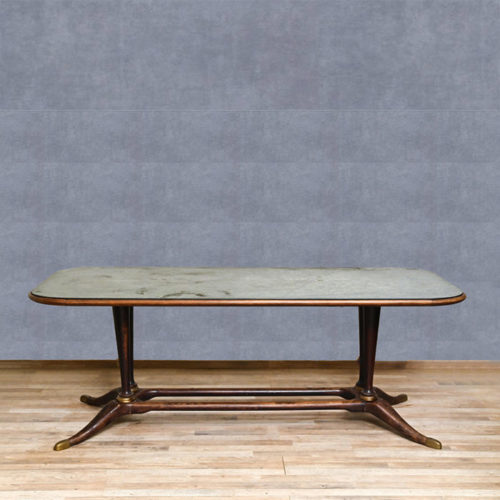 1940s table, of Italian production, with green marble top, excellent structural condition, to be resumed in the finish. Period: 1940s Measurements: H 79 x W 197 x D 90 cm
1940s table, of Italian production, with green marble top, excellent structural condition, to be resumed in the finish. Period: 1940s Measurements: H 79 x W 197 x D 90 cm -
Out of stock
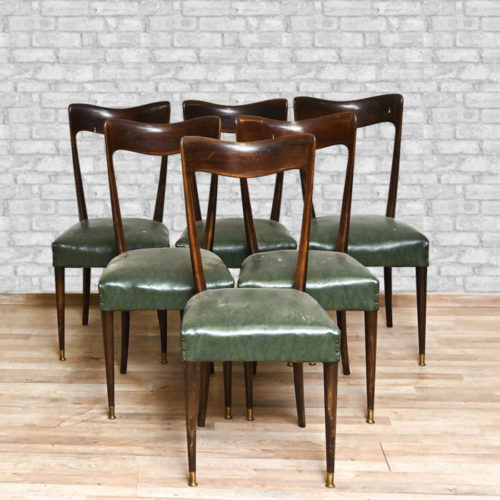 Group of six 40s chairs, made in Italy, with seat in green sky. In excellent structural condition, they are to be resumed in the finish. Period: 1940s Measurements: H 104 x W 45 x D 45 / H Seat 49 cm
Group of six 40s chairs, made in Italy, with seat in green sky. In excellent structural condition, they are to be resumed in the finish. Period: 1940s Measurements: H 104 x W 45 x D 45 / H Seat 49 cm -
Out of stock
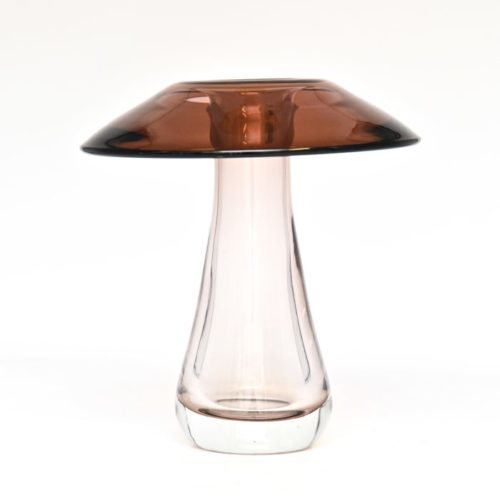 Crystal vase by Antonio Imperatore from the 1980s. This vase was handcrafted in Murano, Italy, by Cristallerie Antonio Imperatore around 1980. It features a clear cylindrical body that gently widens towards its base which represents the "stem" of the mushroom, with a domed upper part in translucent smoked amber glass with a circular hole in the center. In excellent condition. Period: 1980s Measurements: H 28 x Ø 27 cm
Crystal vase by Antonio Imperatore from the 1980s. This vase was handcrafted in Murano, Italy, by Cristallerie Antonio Imperatore around 1980. It features a clear cylindrical body that gently widens towards its base which represents the "stem" of the mushroom, with a domed upper part in translucent smoked amber glass with a circular hole in the center. In excellent condition. Period: 1980s Measurements: H 28 x Ø 27 cm -
Out of stock
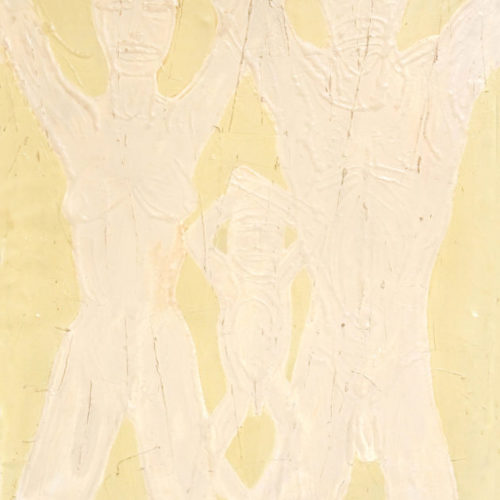 "Primitive family" Oil on canvas by Nik Spatari. Signed on the top right and written on the back "Nik Sparati, Via Solferino 11 Milano". Painting from 1970, taken from the painting exhibited at the 64th Salotto exhibition in 1969. Period: 1970 Measurements: In frame H 124 x W 112 x D 2 / Canvas H 119.5 x W 109 cm
"Primitive family" Oil on canvas by Nik Spatari. Signed on the top right and written on the back "Nik Sparati, Via Solferino 11 Milano". Painting from 1970, taken from the painting exhibited at the 64th Salotto exhibition in 1969. Period: 1970 Measurements: In frame H 124 x W 112 x D 2 / Canvas H 119.5 x W 109 cm -
Out of stock
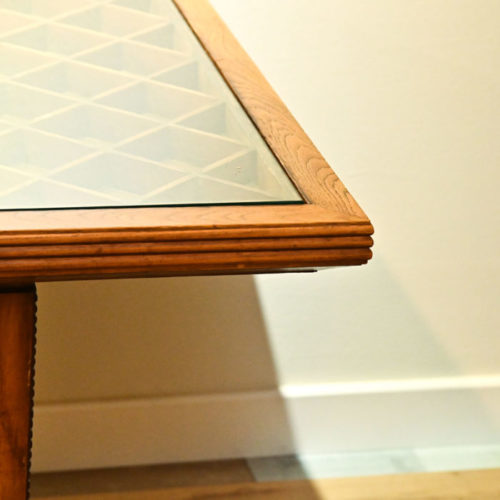 1940's table in chestnut and glass top, with particular cross work. In excellent condition. Period: 1940s Measurements: H 78 x W 189.5 x D 94.5 cm
1940's table in chestnut and glass top, with particular cross work. In excellent condition. Period: 1940s Measurements: H 78 x W 189.5 x D 94.5 cm -
Out of stock
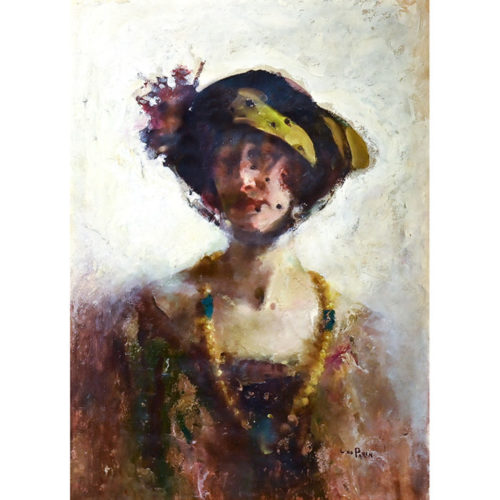 "Woman with veil" oil on paper by Gino Parin. The painting is from the 20s / 30s of the twentieth century, has a beautiful coeval gilded wood frame. The picture and the frame need some cleaning. It comes from a private collection from Biella. Gino Parin was born in Trieste in 1876. His real name was Federico Gino Pollack. He began his artistic education in the studio of the Trieste painter Eugenio Scomparini and then continued at the Venetian Girolamo Navarra's one. At 19 he went to Munich to attend the Academy where he attended the courses of Karl Raupp and became acquainted with the painting of the Pre-Raphaelites, Lenbach, von Marées and von Stuck. Having become a member of the Münchener Künstler Genossenschaft, he often exhibited at the Glaspalast. He traveled extensively in Europe, visiting Switzerland, France and England. From 1910 he began to participate in the collective exhibitions of the Trieste Artistic Circle. Here he settled permanently at the outbreak of the First World War. He participated to the Biennials of 1921, 1924, 1928 and 1932. In 1923 he received the gold medal at the Turin Quadrennial. During this period his style, from the original German academic setting, evolved towards a personal reworking of the taste of the Deco years. His production, mainly focused on female portraits and interior painting, earned him the definition of "painter of beautiful women". Deported by the Germans in 1944, he died in the Bergen Belsen camp. Period: 1920s / 30s Measurements: In frame H 102 x W 82 x D 7.5 / Canvas H 79 x W 59 cm
"Woman with veil" oil on paper by Gino Parin. The painting is from the 20s / 30s of the twentieth century, has a beautiful coeval gilded wood frame. The picture and the frame need some cleaning. It comes from a private collection from Biella. Gino Parin was born in Trieste in 1876. His real name was Federico Gino Pollack. He began his artistic education in the studio of the Trieste painter Eugenio Scomparini and then continued at the Venetian Girolamo Navarra's one. At 19 he went to Munich to attend the Academy where he attended the courses of Karl Raupp and became acquainted with the painting of the Pre-Raphaelites, Lenbach, von Marées and von Stuck. Having become a member of the Münchener Künstler Genossenschaft, he often exhibited at the Glaspalast. He traveled extensively in Europe, visiting Switzerland, France and England. From 1910 he began to participate in the collective exhibitions of the Trieste Artistic Circle. Here he settled permanently at the outbreak of the First World War. He participated to the Biennials of 1921, 1924, 1928 and 1932. In 1923 he received the gold medal at the Turin Quadrennial. During this period his style, from the original German academic setting, evolved towards a personal reworking of the taste of the Deco years. His production, mainly focused on female portraits and interior painting, earned him the definition of "painter of beautiful women". Deported by the Germans in 1944, he died in the Bergen Belsen camp. Period: 1920s / 30s Measurements: In frame H 102 x W 82 x D 7.5 / Canvas H 79 x W 59 cm -
Out of stock
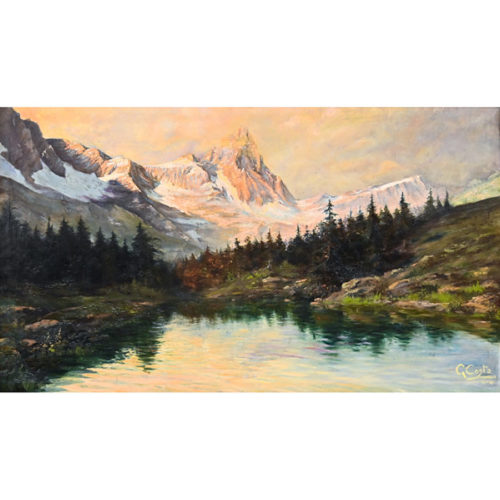 "The Matterhorn with the blue lake" oil on canvas from the early 1920s by Giovanni Battista Costa (Rapallo 1858 - Genoa 1838). The painting has been restored. Giovanni Battista Costa was born in Rapallo in 1858 in a wealthy family and dedicated his entire life to art. He participated, since 1879, in the exhibitions of the Promoting Society of Fine Arts in Genoa and in numerous other important Italian expositions, exhibiting, until 1921, over 100 paintings, mainly landscapes, seascapes and portraits. In 1895 he was appointed Academic of Merit of Ligustica, where he, too, teached. He began his artistic studies at the Ligustica Academy (and partly in Rome), soon going from a painting linked to tradition to the execution of works from life, probably under the guidance of Tammar Luxoro director, from 1874, of the new Landscape School. Consequently, the links with the Genoese Gray School, the Rivara School (in Piedmont) and the Tuscan Macchiaiolo movement appear to be close. The analysis of some of his works lead us to bring Costa closer to some Lombard painters of the 19th century: for example Carcano, especially for the softness of the colours. He takes part in numerous national exhibitions: awarded in 1897 in Venice, he participates in the National Exhibition of Fine Arts in Turin in 1898; in 1906 we find it at the National Exhibition of Fine Arts in Milan; also worth mentioning is his participation in the first Quadrennial Exhibition in Turin in 1902. Giovanni Battista Costa was also a skilled portrait painter and painted in Venice, Parma, Viareggio, Ivrea, Engadina, Valle d’Aosta. Even though he was shy and solitary, he was part of two important schools: the Ligurian Artistic Family (1893 -1910 circa) and the Teatro Group (from 1908); refers to the upper room of the Caffè degli Amici of the Carlo Felice Theater. He is an artist particularly attentive to the social problems of the late nineteenth century. His works appear, in retrospect, in Genoa at the exhibition of Ligurian Painters of the Nineteenth Century (Palazzo Rosso, 1938) and at the Commemorative Exhibition at the San Matteo Gallery, 1952. In his maturity he turned his interest to the representation of mountain landscapes. In conclusion, we can identify three different ways of painting by Costa: the first is related to academic painting, a bit rigid (church interiors and portraiture); the second, realist, with warm colours and close to the themes of the Grays and Rivarians (affinity with Benedetto Musso). Period: 1920s Measurements: In frame H 125 x W 195 x D 6 / Canvas H 101 x W 172 cm
"The Matterhorn with the blue lake" oil on canvas from the early 1920s by Giovanni Battista Costa (Rapallo 1858 - Genoa 1838). The painting has been restored. Giovanni Battista Costa was born in Rapallo in 1858 in a wealthy family and dedicated his entire life to art. He participated, since 1879, in the exhibitions of the Promoting Society of Fine Arts in Genoa and in numerous other important Italian expositions, exhibiting, until 1921, over 100 paintings, mainly landscapes, seascapes and portraits. In 1895 he was appointed Academic of Merit of Ligustica, where he, too, teached. He began his artistic studies at the Ligustica Academy (and partly in Rome), soon going from a painting linked to tradition to the execution of works from life, probably under the guidance of Tammar Luxoro director, from 1874, of the new Landscape School. Consequently, the links with the Genoese Gray School, the Rivara School (in Piedmont) and the Tuscan Macchiaiolo movement appear to be close. The analysis of some of his works lead us to bring Costa closer to some Lombard painters of the 19th century: for example Carcano, especially for the softness of the colours. He takes part in numerous national exhibitions: awarded in 1897 in Venice, he participates in the National Exhibition of Fine Arts in Turin in 1898; in 1906 we find it at the National Exhibition of Fine Arts in Milan; also worth mentioning is his participation in the first Quadrennial Exhibition in Turin in 1902. Giovanni Battista Costa was also a skilled portrait painter and painted in Venice, Parma, Viareggio, Ivrea, Engadina, Valle d’Aosta. Even though he was shy and solitary, he was part of two important schools: the Ligurian Artistic Family (1893 -1910 circa) and the Teatro Group (from 1908); refers to the upper room of the Caffè degli Amici of the Carlo Felice Theater. He is an artist particularly attentive to the social problems of the late nineteenth century. His works appear, in retrospect, in Genoa at the exhibition of Ligurian Painters of the Nineteenth Century (Palazzo Rosso, 1938) and at the Commemorative Exhibition at the San Matteo Gallery, 1952. In his maturity he turned his interest to the representation of mountain landscapes. In conclusion, we can identify three different ways of painting by Costa: the first is related to academic painting, a bit rigid (church interiors and portraiture); the second, realist, with warm colours and close to the themes of the Grays and Rivarians (affinity with Benedetto Musso). Period: 1920s Measurements: In frame H 125 x W 195 x D 6 / Canvas H 101 x W 172 cm -
Out of stock
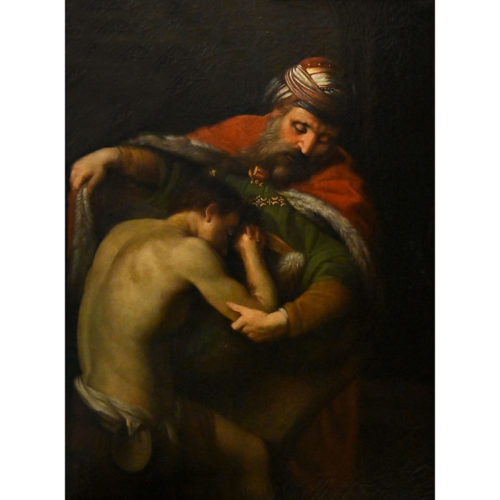
"The return of the prodigal son" oil on canvas from the second half of the 19th century. With coeval wooden frame and gilded leaf tablet. The work is in fair condition, to be restored.
Copy of "The Return of the Prodigal Son" by Pompeo Batoni, 1773, is now conserved at the Kunsthistorisches Museum, Vienna.
The parable of the prodigal son (Luke 15: 11-32) tells of the forgiveness of a father who welcomes his younger son, after he had squandered his part of his inheritance.Period: Second half of the 19th century
Measurements: In frame H 155 x W 118 x D 3 / Canvas H 135 x W 99 cm
-
Out of stock
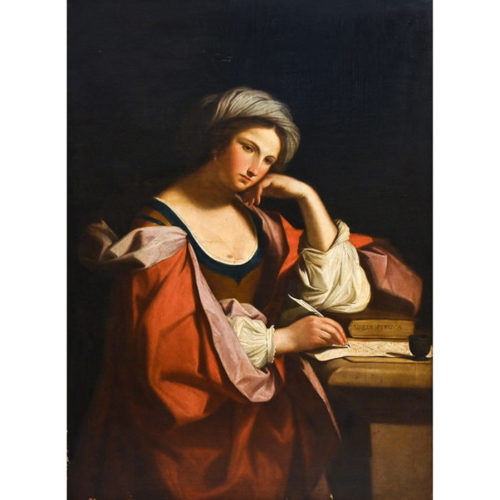 "Sibilla Persica" oil on canvas, a work made between the eighteenth and early nineteenth century. Large painting, of excellent quality, depicting the Persian Sibyl. Coeval frame, re-painted, the surface has no previous restorations, apart from small touches to be done, it is in excellent condition. The painting is a copy of the "Persian Sibyl" of 1647, preserved in the Capitoline Museums, in Rome, by Giovanni Francesco Barbieri, known as Guercino (1591-1666), one of the most important Italian painters of the 17th century. The Sibyl is a mythological figure present in both Greek and Roman culture. The classical tradition tells us that she was dealing with virgin women endowed with prophetic virtues, derived from the intercession of a divinity (which was usually Apollo); they were therefore able to provide responses or make predictions and were worshiped for this. The first historical reference to the Sibyls is found among the works of Plato where, however, he indicates only one. Varrone will be the first to provide a real list of these mythological figures among which the Persian Sibyl will also appear, the subject of this portrait, counted among the oldest. The classical tradition divided them into groups, based on their geographical origin: oriental, Greek-Ionic and Greek-Italic; the Persian Sibyl (or Persian) belonged to the eastern group. Period: Between the 18th and early 19th centuries Measurements: In frame H 145 x W 109 x D 4 / Canvas H 135 x L 98.5 cm
"Sibilla Persica" oil on canvas, a work made between the eighteenth and early nineteenth century. Large painting, of excellent quality, depicting the Persian Sibyl. Coeval frame, re-painted, the surface has no previous restorations, apart from small touches to be done, it is in excellent condition. The painting is a copy of the "Persian Sibyl" of 1647, preserved in the Capitoline Museums, in Rome, by Giovanni Francesco Barbieri, known as Guercino (1591-1666), one of the most important Italian painters of the 17th century. The Sibyl is a mythological figure present in both Greek and Roman culture. The classical tradition tells us that she was dealing with virgin women endowed with prophetic virtues, derived from the intercession of a divinity (which was usually Apollo); they were therefore able to provide responses or make predictions and were worshiped for this. The first historical reference to the Sibyls is found among the works of Plato where, however, he indicates only one. Varrone will be the first to provide a real list of these mythological figures among which the Persian Sibyl will also appear, the subject of this portrait, counted among the oldest. The classical tradition divided them into groups, based on their geographical origin: oriental, Greek-Ionic and Greek-Italic; the Persian Sibyl (or Persian) belonged to the eastern group. Period: Between the 18th and early 19th centuries Measurements: In frame H 145 x W 109 x D 4 / Canvas H 135 x L 98.5 cm